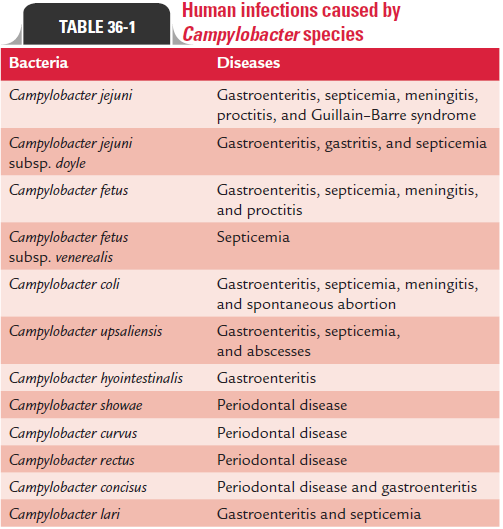Chapter: Microbiology and Immunology: Bacteriology: Campylobacter and Helicobacter
Campylobacter: Properties of the Bacteria
Campylobacter
Campylobacter infections are one of the most common bacte-rial infections in humans. They cause both diarrheal and other systemic diseases. The generic name Campylobacter is derived from the Greek word Kampylos meaning curved rod. The genus Campylobacterresembles the genus Vibrio in being motile bymeans of polar flagella and in being curved Gram-negative bacilli and oxidase positive. They, however, differ from vibrios (a) in being microaerophilic, (b) not fermenting carbohydrates and (c) having a lower guanosine and cytosine content of DNA. The genus Campylobacter consists of 18 species and subspecies, of which 11 species are known to cause infections in humans. These species cause both intestinal and extraintestinal dis-eases (Table 36-1). Campylobacter jejuni andCampylobacter fetus are the two most important species that cause most of the Campylobacter infections in humans.

Properties of the Bacteria
◗ Morphology
Campylobacter spp. shows following morphological features:
· Campylobacter are small, comma-shaped, Gram-negativerods. They vary in width from 0.2 to 0.5 mm.
· They show a rapid darting motility in cork screw fashion by means of a single polar flagellum at one or both poles (monotrichous/amphitrichous).
· They are nonsporing bacteria.
◗ Culture
Campylobacter spp. grow more slowly than other enteric bacteria. Campylobacter are microaerophilic, requiring an atmosphere with decreased oxygen concentration (5%) and increased car-bon dioxide concentration (5–10%) for their growth. Most spe-cies including C. jejuni, Campylobacter coli, Campylobacter lari, and Campylobacter hyointestinalis grow well at 42°C, hence are called thermophilic bacilli.
Selective media for Campylobacter species are blood-based and antibiotics-containing media, such as Skirrow’s, Butzler, and Campy-BAP selective media. Campylobacter on these media produce well-formed colonies after 48 hours of incubation.
C. jejuni produces moist, gray or colorless, flat, and non-hemolytic colonies on this medium. Other Campylobacter species produce circular and convex colonies.
◗ Biochemical reactions
Campylobacter spp. show following reactions:
· Campylobacter are relatively biochemically inert.
· They do not produce indole.
· They are oxidase positive, catalase positive (C. jejuni subsp. doyle is an exception), and nitrate positive.
· C. jejuni is the only species that hydrolyzes sodium hippurate.
◗ Other properties
Susceptibilitytophysicalandchemicalagents: Campylobacterspp. survive at 4°C in Cary–Blair transport medium for many weeks.Campylobacter spp. are sensitive to hydrochloric acid in the stomach, and so conditions that decrease or neutralize gas-tric acid secretion reduce the amount of inoculum needed to cause disease.
Related Topics